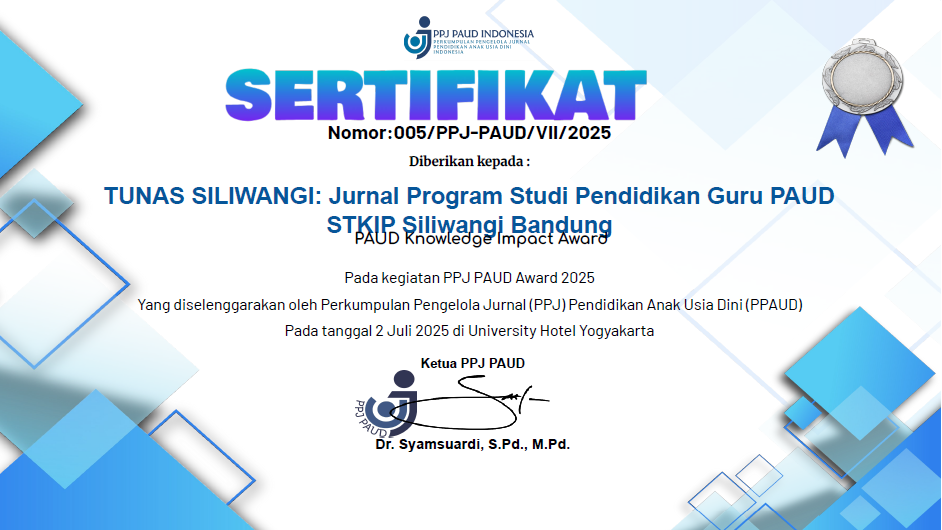Learning analysis of "Hayu Batur Dance" to improve kinesthetic intelligence in early childhood
Peningkatan kecerdasan kinestetik Melalui Pembelajaran "Tari Hayu Batur"
DOI:
https://doi.org/10.22460/ts.v10i1.4042Keywords:
Early Childhood, Kinesthetic intelligence, Dance learning “hayu batur”Abstract
Kinesthetic intelligence is intelligence where a person is skilled at using their body parts. Kinesthetic intelligence problems tend to have difficulty maintaining balance. This research aims at the importance of developing kinesthetic intelligence from an early age. The research uses a qualitative approach with descriptive methods. The methods used to collect data in this research include observation and interviews. In qualitative data analysis, there are three main stages, namely data reduction, data presentation, and drawing conclusions. The results of observations and interviews in Class B3 of Artanita Al- Khoeriyah Kindergarten, Hayu Batur dance learning provides changes, namely children with various difficulties are able to move all or part of their body, especially in coordinating movements between the head, legs and hands in an agile and flexible manner. Thus, learning the Hayu Batur dance has the potential to be a means of optimally increasing the development of kinesthetic intelligence in children.
References
Creswell, J. W. (2014). Qualitative Research & Research Design . Student Library.
Miles, M B. & Huberman, M. (1992). Qualitative Data Analysis . University of Indonesia Publishers.
Muriyanto, M. (2019). The Constraints in Teaching Islamic Education in the Classroom. Scholar , 1 (2),
–27. https://doi.org/10.35438/cendekiawan.v1i2.159
Musfiroh, T. (2013). Development of Multiple Intelligences . Open University.
Rahayu, I. (2021). Hayu Batur Dance by Irawati Durban Ardjo at Pusbitari Studio Bandung .
BandungIndonesian Arts and Culture Institute.
Rahman, H. (2019). Early Childhood Learning Models Theory and Implementation . Ar-Ruzz Media. Sobariah, S., & Santana, FDT (2019). Improving Kinesthetic Intelligence in Early Childhood Through the
Mapag Layung Dance Media. CERIA (Smart Energetic Responsive Innovative Adaptive) , 2 (6), 370.
https://doi.org/10.22460/ceria.v2i6.p370-375
Sugiyono. (2019). Quantitative and Qualitative Research Methodologies and R&D . ALPHABET.
Sundari, & Setyo, R. (2016). Personality Development in Learning Dance at School. Journal of Imagination,
X(1),61–66.https://journal.unnes.ac.id/nju/index.php/imajinasi/article/view/8817/5780 Wahyuningtyas, R., & Sulasmono, BS (2020). The Importance of Media in Learning to Improve Learning
Outcomes in Elementary Schools. Educative: Journal of Educational Sciences , 2 (1), 23–27.
https://doi.org/10.31004/edukatif.v2i1.77
Wiwik Pratiwi. (2017). The Concept of Play in Early Childhood. TADBIR: Journal of Islamic Education
Management , 5 (2), 106–117.
Yeniningsih, TK (2018). Dance Education . Syiah Kuala University Press.
Yuningsih, R. (2015). Increasing Kinesthetic Intelligence through Learning the Basic Movements of the
Minang Dance (Group Action Research B1 at State Kindergarten 01 Sungai Pagu, South Solok Regency, 2015 ). Journal of Early Childhood Education , 9 (2), 233–250
Downloads
Published
Issue
Section
License
Copyright (c) 2025 Rosa Nur Anisa, Sima Mulyadi, Rosarina Giyartini

This work is licensed under a Creative Commons Attribution-ShareAlike 4.0 International License.
The author is responsible for acquiring the permission(s) to reproduce any copyrighted figures, tables, data, or text that are being used in the submitted paper. Authors should note that text quotations of more than 250 words from a published or copyrighted work will require grant of permission from the original publisher to reprint. The written permission letter(s) must be submitted together with the manuscript.






